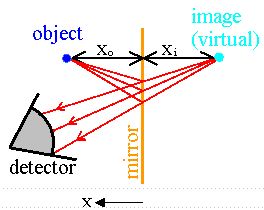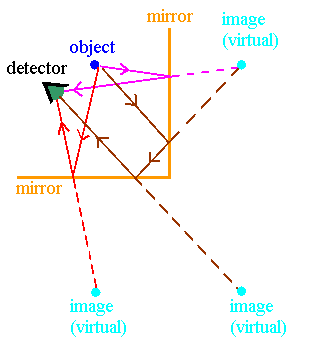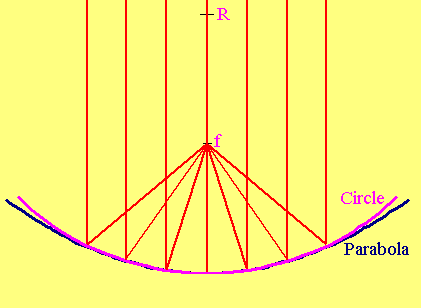Images
The purpose of most optical instruments is to produce an
images. Images can be formed by reflection and
refraction.
What is an image?
We see objects, because they either emit or reflect light. We visually
identify objects by the pattern of light that they emit or reflect. We gather
some portion of that light on a detector (our eyes). In interpreting the
pattern, we implicitly assume that the light traveled in a straight line from
the object to the detector.
- A real image of an object produces
the same pattern of light as the object does somewhere in space. Some
portion of the light from the real image reaches our detector along a
straight-line path. The detector cannot distinguish between light coming
from the object and light coming from the image. We interpret the same
patterns in the same way.
- A virtual image is the apparent
position from which a pattern of light reaches our detector, if we make the
assumption that it has traveled from its source to the detector along a
straight-line path. Virtual images are formed when light from an object or
from an image is reflected or bend on the way to the detector.
Curved mirrors can produce real and virtual images by reflection. A flat
mirror only produces virtual images.
 Consider a flat
mirror. Light rays coming from any point on the object reflect off the mirror before hitting a detector. For each ray θi = θr.
The rays reflect in such a way that they seem to come from a point behind the
mirror. For the detector, the apparent position of the object point is behind the mirror.
That position is the image point. Let
xo denote the perpendicular distance of the object point from the mirror
surface, and let xi denote the perpendicular distance of the image
point
from this surface. If we let distances in front of the
mirror be positive and distances behind the mirror be negative, then we
have xo + xi = 0.
Consider a flat
mirror. Light rays coming from any point on the object reflect off the mirror before hitting a detector. For each ray θi = θr.
The rays reflect in such a way that they seem to come from a point behind the
mirror. For the detector, the apparent position of the object point is behind the mirror.
That position is the image point. Let
xo denote the perpendicular distance of the object point from the mirror
surface, and let xi denote the perpendicular distance of the image
point
from this surface. If we let distances in front of the
mirror be positive and distances behind the mirror be negative, then we
have xo + xi = 0.
For mirrors, negative image distances are associated with virtual images and
positive image distances are associated with real images.
Virtual images appear behind the mirror, real images appear in front of the
mirror.
 Multiple images can be formed by combinations of
flat mirrors. In the picture
to the right, light bouncing off one or both of the mirrors can reach the eye along
three different paths. The detector sees three virtual images.
Multiple images can be formed by combinations of
flat mirrors. In the picture
to the right, light bouncing off one or both of the mirrors can reach the eye along
three different paths. The detector sees three virtual images.
Problem:
Determine the minimum height of a vertical, flat mirror in which a
person 5'10'' in height can see his or her full image.
Solution:
- Reasoning:
There must be a way to reflect rays coming from the foot
and rays coming from the head in a way so that they reach the eye. (See
image.) The height of the mirror must be half the height of the person, in this
case 2'11''.

Curved Mirrors
 Light rays from a distant star are nearly perfectly parallel to each other
when they reach Earth. To produce a bright image of the star we want to gather
as much light from the star as possible and bring it together in one spot,
called a focus. A mirror with a
parabolic surface can perfectly focus incoming light rays parallel to its axis. It produces a real image in the focal point of the parabola. A parabola is the
locus of all points, which are equidistant from a line and a point (the focal
point). All light rays from a distant source approaching the parabola parallel
to its symmetry axis and reflecting from its surface have the same minimum
travel time to the focal point of the parabola. By Fermat's principle, light will
therefore take all these paths, and the rays will come together at the focus.
Light rays from a distant star are nearly perfectly parallel to each other
when they reach Earth. To produce a bright image of the star we want to gather
as much light from the star as possible and bring it together in one spot,
called a focus. A mirror with a
parabolic surface can perfectly focus incoming light rays parallel to its axis. It produces a real image in the focal point of the parabola. A parabola is the
locus of all points, which are equidistant from a line and a point (the focal
point). All light rays from a distant source approaching the parabola parallel
to its symmetry axis and reflecting from its surface have the same minimum
travel time to the focal point of the parabola. By Fermat's principle, light will
therefore take all these paths, and the rays will come together at the focus.
A concave mirror with a spherical surface
focuses light similarly to a parabolic mirror as long as the angle subtended by
the spherical mirror section is small. A spherical mirror has a radius of
curvature R and a focal length f = R/2. The focal length f is the distance
between the focus and the surface of the mirror. The figure on the right compares a parabolic and a concave spherical
surface with the same focal length f. Near the symmetry axis or
optical axis the curves are nearly identical.
As long as all light rays stay close to and make small angles with the optical axis,
we can write down a simple formula for spherical mirrors relating object and
image distances and the radius of curvature and focal length. This formula
is valid in the paraxial approximation.
If an object is placed in front of a
spherical mirror at an object distance xo,
then an image is formed at an image distance xi, where xo
and xi satisfy the mirror equation,
1/xo + 1/xi
= 1/f = 2/R.
Sign conventions for the mirror equation:
xi is positive for a real image in front of the mirror surface, and xi is negative
for a virtual image behind the mirror surface.
xo
and xi are the perpendicular distances from the center plane of the
mirror as shown in the drawing below.
The focal length f and the radius of curvature R = 2f
are positive for a concave mirror and negative for a convex mirror.
For a concave mirror the reflecting surface bulges inward, and for a
convex mirror the reflecting surface bulges outward.
Ray tracing
Please watch the Youtube video "Ray
Diagrams - Mirrors".

We can determine the positions and sizes of images of points formed by
spherical mirrors geometrically by drawing ray
diagrams. Only two incident rays and their reflections must be drawn. The intersection of the two reflected rays, or, for divergent rays, the
intersection of their backward extensions, marks the position of the image of
your chosen point on the object. Choose two or more of the rays listed
below.
- Draw the object in front of the mirror surface.
Draw an incident ray
parallel to the optical axis from a point on the object to the mirror line, and a
reflected ray from the mirror line through f.
(The reflected ray, or an extension
of the reflected ray must pass through f.)
- Draw an incident ray through f, and a reflected ray parallel to
the optical axis.
(The incident ray, or an extension of the incident
ray must pass through f. This can be done if the object is not located a
distance f in front of the mirror.)
- Draw a ray through the
center of curvature R. This ray reflects back onto itself.
(The ray or its extension must pass through R.
This can be done if the object is not located a distance r in front of the
mirror.)
- If you have a protractor, draw a line from the object point to the
point where optical axis intersects the mirror. The reflected ray makes
the same angle with the optical axis as the incident ray.
In the example diagram a real image is formed by a concave mirror.
The image, in general, has not the same size of the object.
We define the
magnification M as the ratio of
the height of the image hi to the height of the object ho. We have
from geometry
M = hi/ho= -xi /xo .
If the magnification is negative, the image is inverted.
Here are some things that always go together for curved mirrors.
- real image <--> inverted image <--> xi is positive
<--> M is negative
- virtual image <--> upright image <--> xi is negative
<--> M is positive
Convex mirrors form only virtual images.
Concave mirrors form real images, if xo > f and virtual
images if xo < f. The type of image formed depends on
the position of the object.
Please watch this
Concave
Mirror Demo: Pendulum.
More Demos:
Problem:
A concave mirror has a radius of curvature of 20 cm. Find the location
of the image for object distances
(a) 40 cm,
(b) 20 cm,
(d) 10 cm.
For each case state whether the image is real or virtual, and upright or
inverted. Find the magnification for each case.
Solution:
- Reasoning:
Use the mirror equation. 1/xo + 1/xi = 1/f. M = -xi/xo.
For a concave mirror f is positive. f = R/2. For this mirror f = 10 cm.
- Details of the calculation:
(a) 1/10 - 1/40 = 1/xi. 3/40 = 1/xi. xi
= 13.33 cm. The image is real.
M = -xi/xo = -1/3. The image is inverted.
(b) 1/10 - 1/20 = 1/xi. 1/20 = 1/xi. xi
= 20 cm. The image is real.
M = -xi/xo
= -1. The image is inverted.
(c) 1/10 - 1/10 = 1/xi. 0 = 1/xi. There is no
finite image distance. All rays from the object are parallel after
reflection.
Problem:
A object 2 cm in height is placed 3 cm in front of a concave mirror. If
the image is 5 cm in height and virtual, what is the focal length of the
mirror?
Solution:
- Reasoning:
Use the mirror equation. 1/xo + 1/xi = 1/f. M = -xi/xo.
- Details of the calculation:
M = -xi/xo = 5/2. xo = 3 cm, therefore xi
=
-7.5 cm.
1/xo + 1/x i= 1/f. 1/3 - 1/7.5 = 1/f. f = 5 cm.
Problem:
If an object placed 10 cm in front of a convex mirror produces a virtual
image 5 cm behind the mirror, what is the focal length of the mirror?
Solution:
- Reasoning:
Use the mirror equation. 1/xo + 1/xi = 1/f.
- Details of the calculation:
1/10 - 1/5 = 1/f. f = -10
cm.
Problem:
A concave mirror forms an inverted image, four times larger than the object.
If the distance between image and object is 1.5 m, find the radius of curvature
R of the mirror.
Solution:
- Reasoning:
Use the mirror equation. 1/xo + 1/xi = 1/f. M = -xi/xo.
An inverted image is a real image. It forms in front of the mirror, the
image distance is positive.
- Details of the calculation:
We have M = -xi/xo = -4, xi = 4xo.
1/xo + 1/(4xo) = 1/f, f = (4/5)xo.
xo is not given, but the distance between xi an xo
is given.
xi = 4xo, and both object and image are in front of
the mirror.
Therefore the distance between image and object = 4xo - xo
= 3xo = 1.5 m.
xo = 0.5 m, f = (4/5)xo = 0.4 m.
R = 2f = 0.8 m.
Embedded Question 3
Explore this interactive
simulation.
- Use a concave mirror to produce a real image which is bigger that
the object.
- Use a concave mirror to produce a real image which is smaller that
the object.
- Use a concave mirror to produce a virtual.
- Use a convex mirror to produce an image.
Discuss these four cases with your fellow students in the discussion forum!
Can you think of situations where spherical mirrors are used to produce the
images explored in case 1 - 4.
If you have a shaving or make-up mirror, you have a concave mirror? Lay it
flat on the floor under a lamp or other object that is mounted on the ceiling.
Stand slightly to the side and try to see the image of the lamp or object.
It may take some moving your head around, but do you see the real image of the
lamp or object floating above the mirror>
Additional information:
The
Physics Classroom: Reflection and the Ray Model of Light
 Consider a flat
mirror. Light rays coming from any point on the object reflect off the mirror before hitting a detector. For each ray θi = θr.
The rays reflect in such a way that they seem to come from a point behind the
mirror. For the detector, the apparent position of the object point is behind the mirror.
That position is the image point. Let
xo denote the perpendicular distance of the object point from the mirror
surface, and let xi denote the perpendicular distance of the image
point
from this surface. If we let distances in front of the
mirror be positive and distances behind the mirror be negative, then we
have xo + xi = 0.
Consider a flat
mirror. Light rays coming from any point on the object reflect off the mirror before hitting a detector. For each ray θi = θr.
The rays reflect in such a way that they seem to come from a point behind the
mirror. For the detector, the apparent position of the object point is behind the mirror.
That position is the image point. Let
xo denote the perpendicular distance of the object point from the mirror
surface, and let xi denote the perpendicular distance of the image
point
from this surface. If we let distances in front of the
mirror be positive and distances behind the mirror be negative, then we
have xo + xi = 0. Multiple images can be formed by combinations of
flat mirrors. In the picture
to the right, light bouncing off one or both of the mirrors can reach the eye along
three different paths. The detector sees three virtual images.
Multiple images can be formed by combinations of
flat mirrors. In the picture
to the right, light bouncing off one or both of the mirrors can reach the eye along
three different paths. The detector sees three virtual images.
 Light rays from a distant star are nearly perfectly parallel to each other
when they reach Earth. To produce a bright image of the star we want to gather
as much light from the star as possible and bring it together in one spot,
called a focus. A mirror with a
parabolic surface can perfectly focus incoming light rays parallel to its axis. It produces a real image in the focal point of the parabola. A parabola is the
locus of all points, which are equidistant from a line and a point (the focal
point). All light rays from a distant source approaching the parabola parallel
to its symmetry axis and reflecting from its surface have the same minimum
travel time to the focal point of the parabola. By Fermat's principle, light will
therefore take all these paths, and the rays will come together at the focus.
Light rays from a distant star are nearly perfectly parallel to each other
when they reach Earth. To produce a bright image of the star we want to gather
as much light from the star as possible and bring it together in one spot,
called a focus. A mirror with a
parabolic surface can perfectly focus incoming light rays parallel to its axis. It produces a real image in the focal point of the parabola. A parabola is the
locus of all points, which are equidistant from a line and a point (the focal
point). All light rays from a distant source approaching the parabola parallel
to its symmetry axis and reflecting from its surface have the same minimum
travel time to the focal point of the parabola. By Fermat's principle, light will
therefore take all these paths, and the rays will come together at the focus.